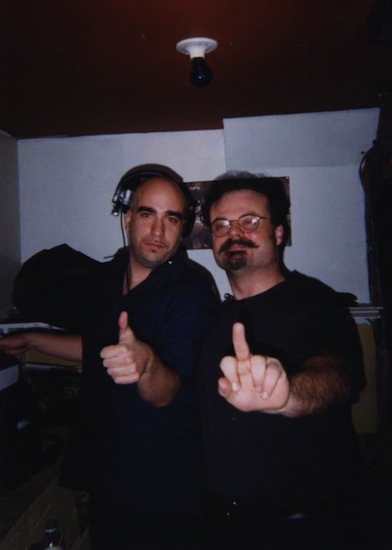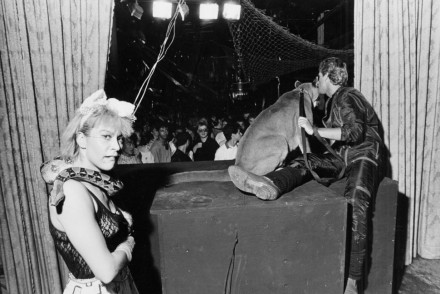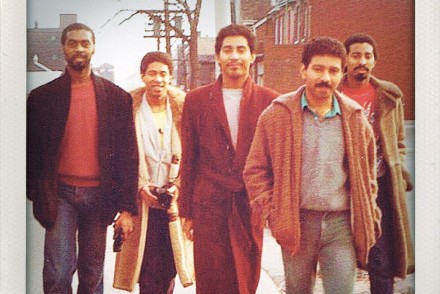Flyer for The Living Room’s “Holiday House” presented by Pat & Mario. Courtesy of Pat Boogie.
Article originally published May 10, 2012 by The Grid online (TheGridTO.com).
This late-’90s venture by the party-starting Sbrocchi and Assoon brothers became the favourite Sunday night spot for a mature crowd of dedicated house heads. It was so beloved, some called it the Toronto house scene’s version of Cheers.
BY: DENISE BENSON
Club: The Living Room, 330 Adelaide St. W.
Years in operation: 1997-2002
History: Though it may be difficult to imagine, just 15 years ago, Toronto’s Entertainment District still had some semblance of cool. It hadn’t yet become overrun with copycat venues, fall-over-drunk partiers, and frustrated residents, while the mad condo-fication we see today hadn’t fully taken hold. There remained a whiff of possibility in the area for those who wanted to open music-minded social spots.
Into this epicentre returned the brothers Assoon. In 1980—when the area was decidedly non-residential and still touted as the Garment District—Albert, Tony, Michael and David Assoon (and partners) opened Twilight Zone on Richmond near Simcoe. The deeply influential after-hours dance club ran until 1989.
Eight years later, Albert and Michael partnered with Anthony Formusa and brothers Tony and Johnny Sbrocchi to open a vastly different venture in a two-storey, Art Deco-style warehouse building near the corner of Peter and Adelaide. It had been home to the Sbrocchis’ fine-dining restaurant Ola, but that hadn’t taken off.
Conversations between Tony and Albert, who’d followed The Twilight Zone by opening the infamous Fresh nightclub at 132 Queen’s Quay E. and later worked for The Guvernment at that same address, led to the development of a new venue. The Living Room opened at 330 Adelaide St. W. in November of 1997, with Albert and Michael Assoon at the creative helm.
“Our inspiration was always house music, and we noticed that it had moved to a different level [in Toronto],” says Michael. “We thought it would be a good time to bring back some of the magic that we had from The Twilight Zone.”
“The Assoons were already legends in their own right, as they were a true party family,” confirms infamous social queen Jennstar, who worked at clubs including Industry before joining The Living Room’s Sunday team. “I think that being back in the district, close to where the original Zone had been, gave the venue some energy. There were a lot of good vibes there.”
Inspired by its Miami namesake, which Albert had visited and been impressed by, The Living Room was intended to be a mature, versatile lounge and dance club.
“We envisioned it to have the comforts of a living room, with lots of couches and art and curtains,” Michael recalls. “I took on the responsibility of the layout, the colors and the logo. Albert and our brother Tony upgraded the sound system.”
Originally licensed for 250 people, but soon increased to 400 after minor renovations, The Living Room’s three rooms paired comfort with a large hardwood dancefloor and clear, booming sound.
“The first DJ booth was in the washroom, with a hole cut into the wall that faced out onto the dancefloor,” shares Andy Roberts, a DJ whose name became synonymous with the club’s Sunday nights. “Eventually a proper DJ booth was built, with a RANE MP2016A and crossover. The sound was exceptional if you didn’t over do it.
“The atmosphere was cozy,” he continues. “It didn’t feel like a medium-sized club; it literally felt like you were at home, and we were having a house party every week.”
Why it was important: Opened a year after Industry and a year before Roxy Blu, The Living Room drew a related clientele, as all three clubs nurtured and hosted Toronto’s underground house movement of the time. The more intimate Living Room was unique in that it attracted a slightly older crowd.
“There were no other venues in the city that offered lounging and dining as we did when we started out,” says Albert Assoon. “There were not many chic lounges like The Living Room that also had the casual attitude we offered as place to dance and have a good time. It was an easygoing, fun place to party at.
“The varied signature nights we had also meant there was something for everybody; we definitely were a non-commercial venue that attracted a mature clientele.”
Initially open only on weekends, the venue began with David Assoon and Nathaniel Garcia promoting Fridays, with a young jojoflores in from Montreal to spin R&B and classic house. Albert, who DJs as Phat Albert, was Saturday’s musical mastermind, and brought blends of soulful house to the tables for more than two years.
“We booked guests like Kenny Carpenter, the original DJ from Studio 54 who also worked under Larry Levan at Paradise Garage,” says Albert. “We’d often brought him in to the Twilight Zone, and he was the top international DJ to promote our Living Room Saturdays.”
There were a number of musically-themed nights at the club over the years, but The Living Room will always be thought of as the home to Hard & Soul Sundays, arguably Toronto’s longest-running underground house weekly. This city’s house heads had already shown they would support on Sundays, having packed Thundergroove at OZ throughout the mid-’90s, and Mark Oliver’s Sunday weekly at Velvet. Oliver was, in fact, an original resident DJ at Hard & Soul when it opened in December of 1997. He and Andy Roberts played as co-residents for months, with DJ Everdelicious Nicole the next to be hired as Roberts’ co-resident.
The night’s original promoter was Gairy Brown a.k.a. Gigi, then also a waiter at The Living Room and now the Executive Director at gay event production company Prism. It was Brown who named the night, grabbing the title from Danny Tenaglia’s 1995 album. Promoter/hosts including Jennstarr, the roller-skating Big Daddy a.k.a. Roman Steel, and Megan McMullen-DeGennaro joined Brown in building a loyal following for Hard & Soul.
“The Sundays became a signature house night in Toronto,” says Albert Assoon. “It was definitely underground, deep, soulful house music that Andy and Nicole played. Generally, 300 to 500 people would come out, and on long weekends they would boost up to 800.”
“Since it was a weekly residency, we were able to introduce new music, and develop what would become a sound unique to Hard & Soul,” says Roberts, who also played a variety of nights at clubs including Mad Bar, Apothecary and Element Bar during his Hard & Soul run.
“The main reason the night thrived, in my opinion, is because Tony Sbrocchi kept it going even though we were pretty slow in the beginning. Most owners these days only give promoters a couple of weeks. Oddly enough, when we first started getting busy on a weekly basis, most of the crowd was coming from the Comfort Zone.”
That said, a lot of the international guests at Hard & Soul—like Sneak, Cajmere, DJ Heather, Mark Farina, Honey Dijon, and J-Dub—had strong ties to Industry, often playing there on a Saturday and The Living Room the next night. People like Jennstar frequented and worked at both venues.
“Andy was the reason I wanted to be involved at Hard & Soul,” says Jennstar, who co-promoted and hosted for two years. “He always had his unique sound. No one was doing Sunday parties at the time, and it was a great night of people who worked in the scene, people who were in the know about music, and those who generally had their finger on the pulse. There was always lots of fun people—gay, straight, all races, and of various ages—cheering and having a great time to great music.”
Roberts attributes the mix of people to the night’s broad range of house, moving from deep to disco, garage and gospel house to funky Chicago sounds. He recalls being an early champion of house tracks that became huge club anthems, citing Armand Van Helden’s “Flowers,” Stardust’s “Music Sounds Better with You,” and “Big Love” by Pete Heller as examples.
Promoter Pat Boogie, a devoted house head who’d long been a regular at the night before he joined the Hard & Soul team in 1999, adds to the musical memories.
“Andy really developed a distinct sound, and had a bunch of anthems,” he says. “A couple of my favorites were DJ Gregory’s “Block Party,” and the absolute number one Hard & Soul anthem, Jasper Street Company’s “God Helps Those (Who Help Themselves.” People would lose their minds when he dropped this gospel house floor stomper!
“I still get goose bumps when I hear the song because it brings back memories of Andy in the booth with his hands in the air, and everyone on the dancefloor singing at the top of their lungs, stomping their feet and clapping their hands. The staff would join in too, bartenders would get on top of the bar and bar backs and security would join everyone on the dance floor. That’s what I loved most about The Living Room: it was a like a family of real characters; everyone got along and helped with the success of the venue. It was like the Toronto house scene’s version of Cheers.”
Boogie, who has since worked for companies including Most Wanted Entertainment, CiRCA Nightclub, and his own Boogie Inc. production company, speaks lovingly of The Living Room and Hard & Soul Sundays, later sub-titled ‘Sunday Religion.’
He tells me about other DJs who graced the booth, like Luc Raymond, Fred Everything, Alton Miller, DJ Deep, and an impressive array of locals including The Stickmen, Nick Holder, Mitch Winthrop, Shawn Riker, Allen Best, Kenny Glasgow and brothers Dino & Terry, who joined Roberts as co-residents after Everdelicious Nicole moved to New York in 2001.
Boogie spills a few fun details about one of The Living Room’s most memorable guests. Back in the days when people could smoke cigarettes anywhere and tobacco companies spent big bucks courting clubbers, Benson & Hedges sponsored a ‘Goldclub’ series of ‘Big DJ, Small Club’ events. This included the legendary Danny Tenaglia at Hard & Soul in December 2000.
”What I remember most about the Tenaglia night—apart from the club fully doubling the sound system—was that the whole DJ booth was full of records,” Boogie recalls. “To this day, I have never seen any DJ bring that many crates to a gig. When I asked some of the other staff about it, they told me that they’d unloaded all of the records from a cube van that Danny’s people drove from New York. Tenaglia played at least an eight-hour set, and the sound system pounded with all of the extra bins. That night was pure insanity.”
While Hard & Soul was handed to a different team at the close of 2001, Roberts and Boogie host occasionally reunion parties to this day.

Luao Party: bartenders JD and Megan McMullen-DeGennaro with Albert Assoon (right). Photo courtesy of Assoon.
Who else played/worked there: Dozens of DJs dropped a variety of sounds at The Living Room over the years, with Gio, James K, Hedley Jones and Chris Sheppard among them. Johnny Quest (a.k.a. Robby Streek) and DJ Astronaught held down a short-lived Wednesday trance night, while Jedi Records and Most Wanted Entertainment promoted the drum ‘n’ bass Silk Thursdays for most of 2002. Silk’s roster of local residents included DJs Ra, Illfingas, and Slip & Slide. DJ Freaky Flow and MC Flipside recorded a live CD for Moonshine Records at Silk, and UK guests included Goldie, Total Science, and Mickey Finn.
As with any good bar, the staff was integral to The Living Room’s vibe, with other star characters mentioned including bartenders JD and Jennifer Hill, and promoter Billy X.
“The staff was like this crazy family,” says Sbrocchi. “We all worked hard together and played hard together. All of the staff—from the door, to the barbacks, bartenders, and DJs—were amazing, and we were fortunate to have them.”
“When it comes down to it, clubs are all about timing, and I think that with The Living Room, the right people came together at the right time,” says Roberts. “I feel very fortunate for it. That’s tough to recreate.”

Andy Roberts (left) with Christian Newhook a.k.a. Dinamo Azari, at The Living Room. Photo courtesy of Pat Boogie.
What happened to it: By 2002, The Living Room had slowed and the lease was set to expire.
“The club closed due to a lengthy court battle with the landlord, who wanted to evict us and build a condo,” says Sbrocchi. “It became too costly to continue.”
330 Adelaide St. W. next housed a variety of businesses, most notably The Roosevelt Room. Today, just like the former site of The Twilight Zone, it is a condo in the making—the 40-storey Peter Street Condos are currently in development.
“Operating a successful club requires a lot of attention and can be hazardous to your health,” summarizes Sbrocchi, who’s now a law student. “If not for the support of my brothers, and the creative input of the Assoons, the Room would never have turned out the way that it did. I’m glad we were able to liven up a scene that has become a homogenized joke. There are days when I really want to do another club just to wake up people and actually give them their money’s worth.”
The Assoons appear to be thinking likewise.
“We are presently engaging in conversation about a space that would mean an up-to-date Twilight Zone,” offers Michael.
“Whenever the opportunity arises for us to open a nightclub, we work to give the city something fresh, exciting and memorable,” says Albert; “And sometimes set new benchmarks.” [Addendum: The Assoons opened Remix Lounge at 1305 Dundas West in 2014.]
In the meantime, DJ, producer and Mixed Signals Music boss Roberts will soon host a new Sunday weekly devoted to “classics from all eras of house music” just down the street. Déjà vu launches June 10 at Parlour Lounge.












2 Comments
Hi there How come article on apothecary !
All comments in the string below have been republished from their original appearance on The Grid website. We’re including the readers’ comments as they add to these Then & Now stories. We look forward to reading new comments here as well.
Roland
Amazing article Denise! The Danny tenaglia night was one of those magical nights where at the end around 9 or 10 in the morning he wasn’t mixing anymore and was just pulling out gems from his numerous crates and saying to a handful of people, “you guys are gonna love this!” or “check this track out!” Also, that pic of Jen the bartender! I totally forgot about her and her energy. She was in my opinion best bartender in the city at the time. Great job Andy and team. Those were special times… 10:51 am on May 27, 2012
Wallace
A night of funky music on Sundays. Bring the funk back Andy! 12:43 pm on May 18, 2012